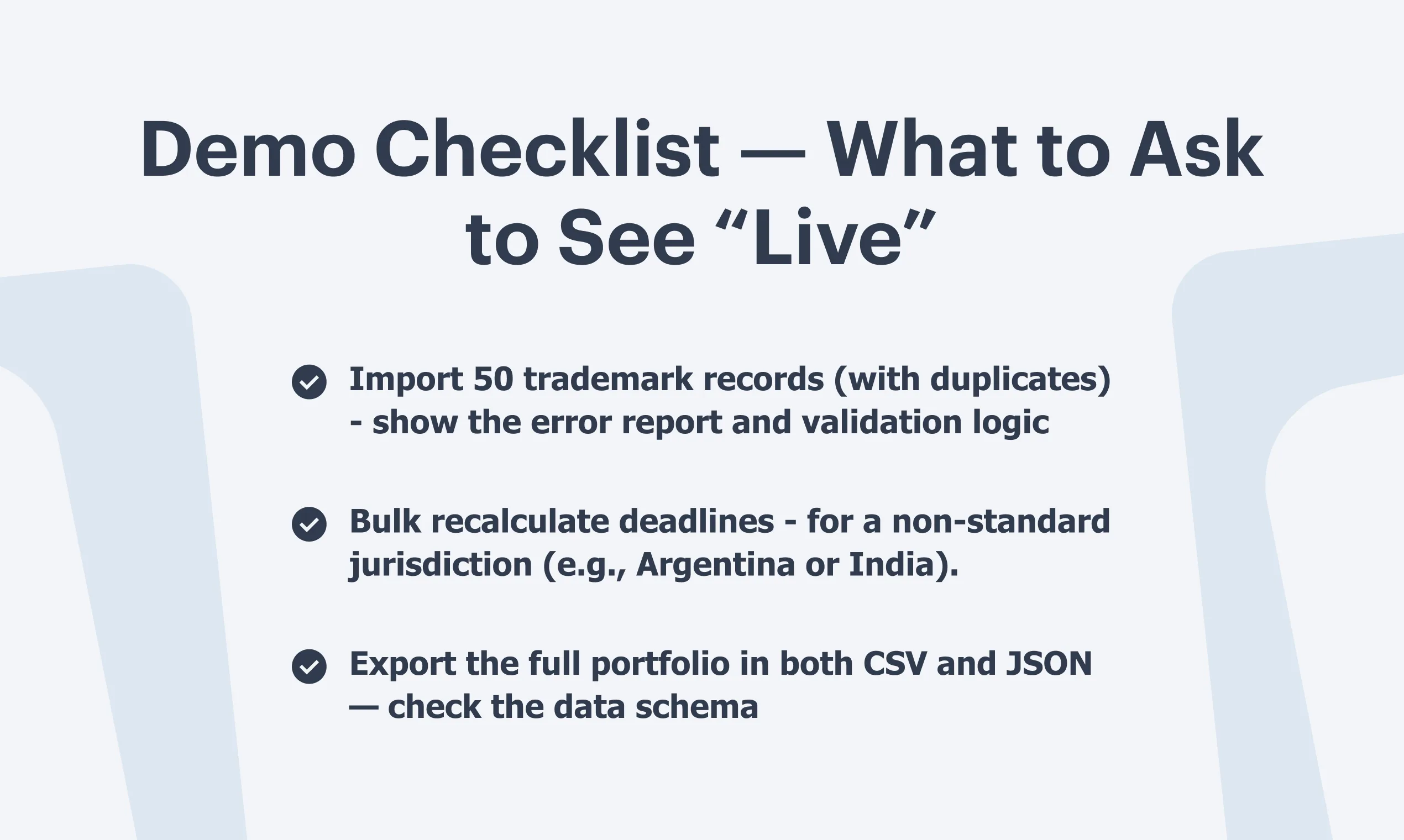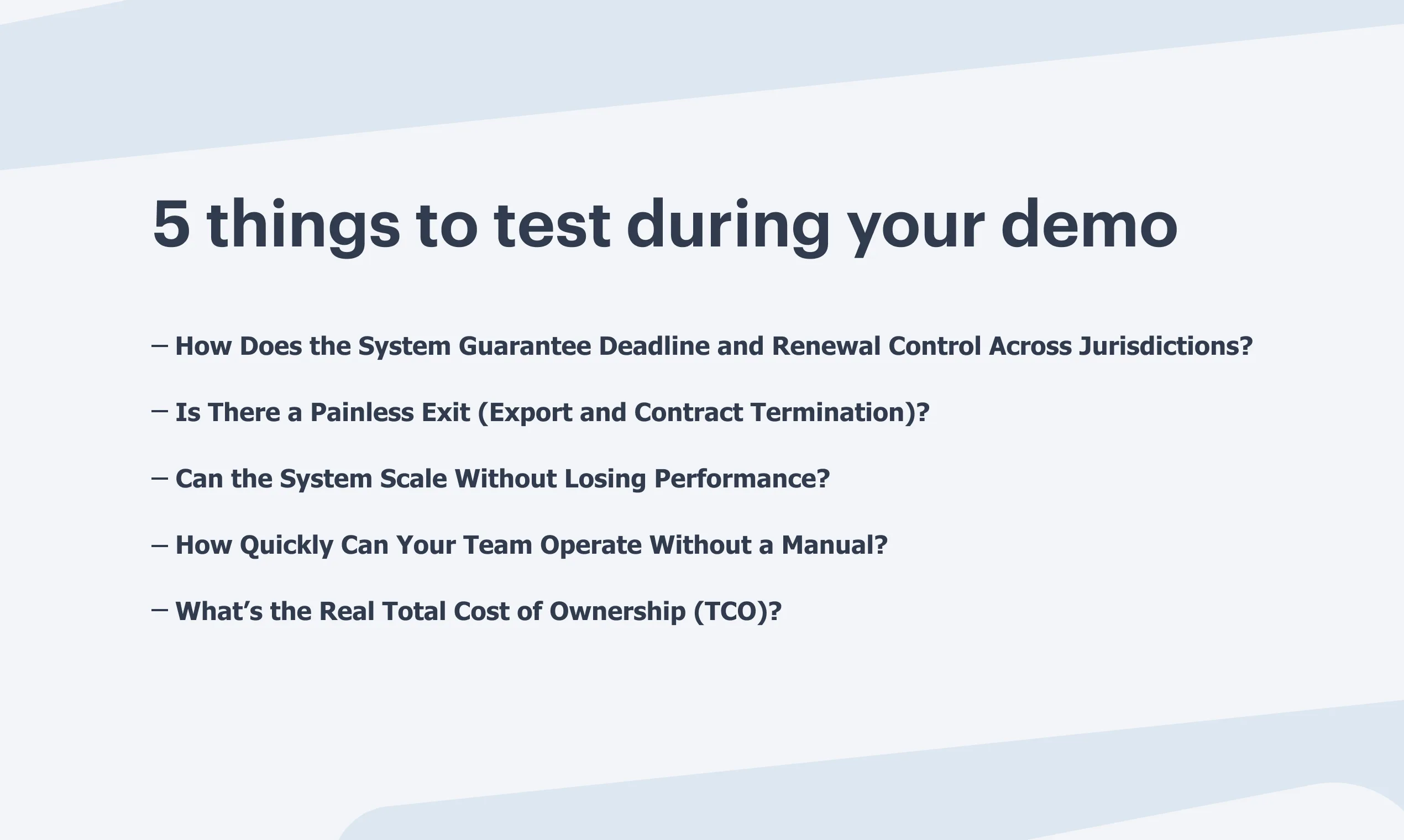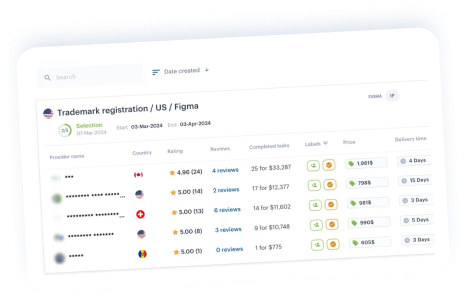Why a Demo Is More Than Just a Show of Features
When it comes to choosing trademark management software, a demo can be deceptive.
Most vendors are eager to showcase their slick dashboards, dashboards filled with colorful graphs, and promises of “AI automation”. Yet, these surface-level features often say little about how the system performs when things get complicated — missed deadlines, complex migration, or a growing portfolio.
The reality is that a proper demo isn’t about “looking good”. It’s about reducing risk and assessing product maturity. The goal is to find out whether this system can actually handle your legal and operational workflows across jurisdictions, languages, and internal teams and without creating new problems.
Your guiding question should be simple: “Will this platform protect my IP assets and scale with my business, or will it add complexity and hidden costs?”
Below are 5 crucial questions to ask during any demo of trademark or IP portfolio management software, with clear instructions on what to request, what to watch for, and how to tell if you’re seeing a mature product.
1. How Does the System Guarantee Deadline and Renewal Control Across Jurisdictions?
Why it matters:
Trademark portfolios are deadline-driven. A single missed renewal or late declaration can mean losing rights in a key market. In many firms, this is still handled manually — with spreadsheets, reminders, and emails. Automation is essential.
Ask to see:
- Automatic imports of status data from official trademark registries.
- Calculations of all critical deadlines (renewals, declarations of use, fees).
- A full audit log of notifications and system alerts.
- Support services if something goes as unexpected
Red flags:
If the presenter mentions manual entry of dates, or says “you’ll just upload an Excel file,” it’s a sign of immaturity. Also beware if there’s no clear data source or no support.
Good answer:
Proven integrations with verified registry data and automated docketing systems that recalculate deadlines dynamically.
At iPNOTE, for example, automatic TM tracking and reminders are built in by default — ensuring no deadline slips through the cracks.
2. Is There a Painless Exit (Export and Contract Termination)?
Why it matters:
A healthy software relationship is based on transparency. You should be able to leave — and take your data — without friction or penalties.
Ask to see:
- A complete export of the portfolio in open formats (CSV, XML, or JSON).
- Data schemas and mapping documentation.
- Step-by-step “how we exit” instructions.
Red flags:
Closed formats, additional fees for data export, or contractual penalties for leaving.
Good answer:
Formalized exit procedures, data export available in self-service mode, and no hidden restrictions.
Mini-scenario:
Your firm merges with another. You should be able to export the full trademark list, with deadlines and documents, in minutes — not wait weeks for the vendor to “prepare the files.”
At iPNOTE you can easily export your portofolio in a few seconds or reach support out for further assistance.
3. Can the System Scale Without Losing Performance?
Why it matters:
Today you may manage 100 marks; next year it could be 10,000. Your software must scale with your growth — without degrading performance or inflating costs exponentially.
Ask to see:
- Performance metrics (e.g., load speed, processing time, user concurrency).
- Behavior under ×10 data growth.
- Examples of clients who scaled portfolios successfully.
Red flags:
System slowdown during bulk actions, pricing tied rigidly to record count, or downtime when importing large datasets.
Good answer:
Elastic architecture, scalable pricing tiers, and no downtime for mass operations.iPNOTE offers all-in-one scaling across TM, patents, and designs — with predictable costs and no hidden charges.
4. How Quickly Can Your Team Operate Without a Manual?
Why it matters:
Even the most powerful software fails if your team can’t use it efficiently. Usability determines adoption and ROI.
Ask to see:
- In-app onboarding and role-specific dashboards.
- A “Day 1” user path showing how a new user handles key tasks.
- A library of micro-videos or guided tours.
Red flags:
Responses like “you’ll get used to it” or lengthy training sessions. Poor UX design often leads to expensive onboarding.
Good answer:
Users can complete basic tasks within hours; a self-help knowledge base supports continuous learning.
Mini-scenario:
A new paralegal joins your firm. Can they add a new mark, set a deadline, and send a client report without formal training? If yes — that’s user-centric design. Enjoy 24/7 support, AI assistant and knowledge base in your tariff if you are using iPNOTE IPMS.
5. What’s the Real Total Cost of Ownership (TCO)?
Why it matters:
The base subscription is rarely the real cost. Integration, updates, API calls, and report generation can add up quickly.
Ask to see:
- A detailed pricing matrix (what’s included vs. optional).
- Pricing behavior when adding users, countries, or marks.
Red flags:
Extra charges for updates, per-report pricing, or API usage fees.
Good answer:
Transparent pricing tiers with predictable scaling. At iPNOTE, plans are structured with full feature access — no hidden paywalls.
Mini-scenario:
If your portfolio doubles, your budget shouldn’t triple. The right vendor makes cost growth linear and predictable.
Before the demo ends, insist on doing these hands-on tests:

This approach reveals real functionality beyond polished slides.
Real-World Scenarios Worth Testing
- Missed renewal: Simulate a delay and see how the system reacts.
- Corrupted import: Can the platform detect mismatched owner names?
- Contract termination: Export all data and verify completeness.
- Sudden growth: Upload a large portfolio — does the system slow down?
Each scenario exposes how the platform behaves under real-world pressure.
A No-Pressure Way to Evaluate Real Value
The best way to de-risk your decision is to request a scenario-based demo using your own data. Combine this with a short pilot phase (sandbox migration, export/import, mass docketing).
In just a few days, you’ll see whether the vendor can deliver on promises or if hidden issues emerge.
This method gives you confidence, reduces transition risk, and ensures your team experiences the product as it truly functions — not as it’s marketed.
Final Thought
A great trademark management demo isn’t about “wow” features.
It’s about trust, transparency, and control — knowing that your IP assets, deadlines, and client data are secure, scalable, and always accessible.
Choose a partner that supports your growth, integrates seamlessly, and helps you stay ahead — not one that locks you in or slows you down.
That’s what separates a flashy tool from a mature IP management platform.







